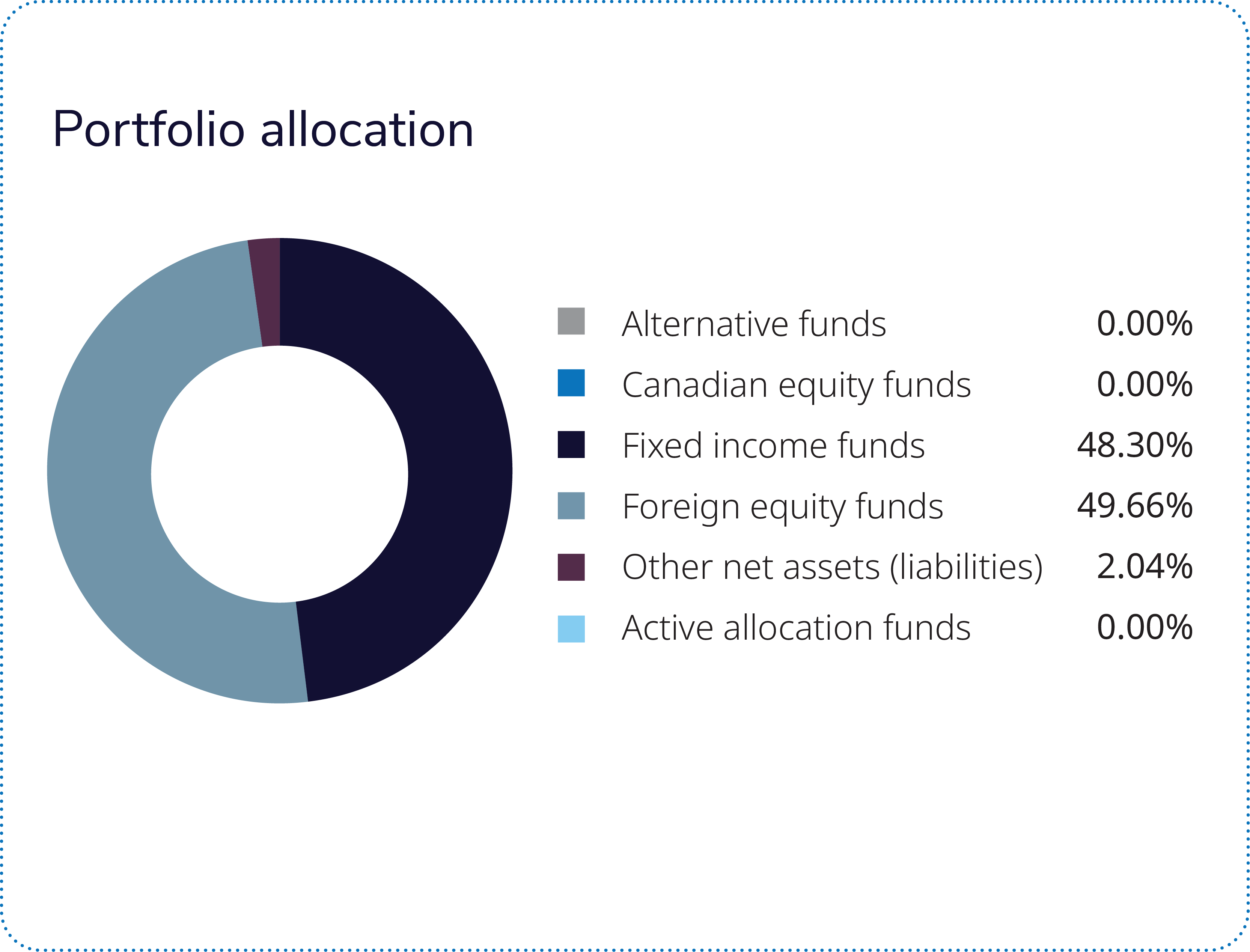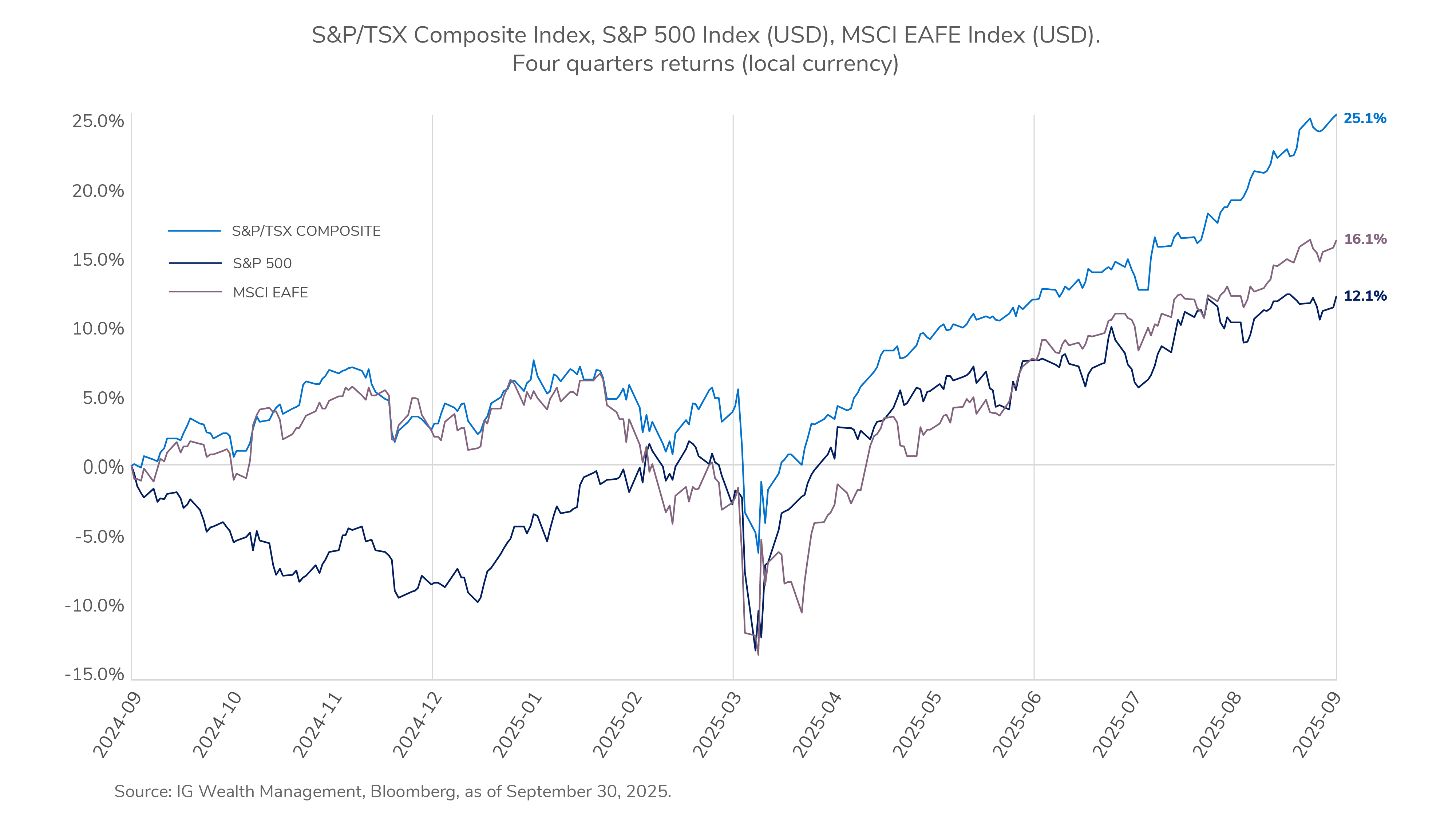Portfolio returns: Q3 2025
| Total Return | 1M | 3M | YTD | 1YR | 3YR | 5YR | 10YR | Since Inc. (Jul 12, 2013) |
IG Income Portfolio – Growth Series F | 2.38 | 4.96 | 7.63 | 9.62 | 10.59 | 6.04 | 5.48
| 5.25 |
Quartile rankings | 3 | 3 | 3 | 3 | 4 | 3 | 3 |
Proudly Canadian
| Total Return | 1M | 3M | YTD | 1YR | 3YR | 5YR | 10YR | Since Inc. (Jul 12, 2013) |
IG Income Portfolio – Growth Series F | 2.38 | 4.96 | 7.63 | 9.62 | 10.59 | 6.04 | 5.48
| 5.25 |
Quartile rankings | 3 | 3 | 3 | 3 | 4 | 3 | 3 |
 The portfolio was up in the quarter.
The portfolio was up in the quarter.
Equity exposure, represented by the portfolio’s 50% allocation to the Mackenzie Global Equity Income Fund, was the largest contributor to performance and outperformed its benchmark. Returns were driven by U.S. equity holdings, primarily through the fund’s 40% allocation to the S&P 500. Stock selection in financials was the largest contributor to outperformance, while materials and consumer staples also added meaningfully. Conversely, stock selection in and underperformance of information technology and industrials detracted modestly from performance. Dividend-paying stocks provided stable, income-driven gains that supported absolute performance but modestly lagged higher-growth equities during the quarter.
The Mackenzie Global Equity Income Fund also utilizes a stock options strategy to help preserve capital during times of severe equity market stress. As expected, the options strategy detracted from returns as equity markets rallied; the opposite is expected when equity markets decline rapidly.
The Mackenzie Unconstrained Fixed Income Fund, representing 21% of the portfolio, was another positive contributor to performance. Relative to its benchmark, an underweight to government bonds, an overweight to corporate bonds and security selection within communication services and financials corporate bonds added value, as did hedged foreign currency exposure.
The Mackenzie Canadian Bond Fund, representing 16% of the portfolio, was another contributor to performance. The fund posted a positive return and outperformed its benchmark. An overweight to corporate bonds and security selection in government bonds were the major contributors to the performance.
The Mackenzie Sovereign Bond Fund, representing 9% of the portfolio, also contributed to the performance. The fund invests in 10-year government bonds and benefited from a decline in Canadian and U.S. yields.
The Mackenzie Gold Bullion Fund, representing 2% of the portfolio and held as an inflation-sensitive asset, performed extremely well this quarter, as the price of gold surged.
The third quarter delivered broad gains across asset classes, with market performance largely overriding a backdrop of cautious sentiment. Investors looked past persistent trade policy headlines, increasingly treating the U.S. administration's tariff policy as noise rather than a core risk. The primary catalysts for the positive performance were a subtle shift toward lower-interest-rate expectations and resilient corporate earnings.
Signals from the U.S. Federal Reserve of imminent rate cuts were followed by a quarter percentage cut in September. Government bond yields eased into the quarter's end, supporting bond prices, while corporate bonds outperformed government bonds.

Our outlook for equities became positive in the period, as global markets proved resilient, with improving earnings revisions and stronger investor sentiment. We believe share valuations in Japan remain reasonable, and longer-term metrics suggest that developed international and emerging markets are more attractively valued than those in the United States and Canada.
We believe policy uncertainty and slower global growth are likely to cap inflation. Because tariff-related price increases appear transitory, we do not expect a lasting impact on fixed income investments. In Canada, we believe softer economic data has increased the likelihood of additional Bank of Canada policy rate cuts. In the United States, a more accommodative tone from the U.S. Federal Reserve and mounting fiscal and debt concerns led markets to price in further interest rate cuts into 2026, which we believe could pressure the U.S. dollar.
Commissions, fees and expenses may be associated with mutual fund investments. Read the prospectus and speak to an IG Advisor before investing. The rate of return is the historical annual compounded total return as of September 30, 2025, including changes in value and reinvestment of all dividends or distributions. It does not take into account sales, redemption, distribution, optional charges or income taxes payable by any securityholder that would have reduced returns. Mutual funds are not guaranteed, values change frequently and past performance may not be repeated. Mutual funds and investment products and services are offered through the Mutual Fund Division of IG Wealth Management Inc. (in Quebec, a firm in financial planning). And additional investment products and brokerage services are offered through the Investment Dealer, IG Wealth Management Inc. (in Quebec, a firm in financial planning), a member of the Canadian Investor Protection Fund.
This commentary may contain forward-looking information which reflects our or third-party current expectations or forecasts of future events. Forward-looking information is inherently subject to, among other things, risks, uncertainties and assumptions that could cause actual results to differ materially from those expressed herein. These risks, uncertainties and assumptions include, without limitation, general economic, political and market factors, interest and foreign exchange rates, the volatility of equity and capital markets, business competition, technological change, changes in government regulations, changes in tax laws, unexpected judicial or regulatory proceedings and catastrophic events. Please consider these and other factors carefully and do not place undue reliance on forward-looking information. The forward-looking information contained herein is current only as of September 30, 2025. There should be no expectation that such information will in all circumstances be updated, supplemented or revised whether as a result of new information, changing circumstances, future events or otherwise.
This commentary is published by IG Wealth Management. It represents the views of our Portfolio Managers and is provided as a general source of information. It is not intended to provide investment advice or as an endorsement of any investment. Some of the securities mentioned may be owned by IG Wealth Management or its mutual funds, or by portfolios managed by our external advisors. Every effort has been made to ensure that the material contained in the commentary is accurate at the time of publication, however, IG Wealth Management cannot guarantee the accuracy or the completeness of such material and accepts no responsibility for any loss arising from any use of or reliance on the information contained herein.
Trademarks, including IG Wealth Management and IG Private Wealth Management, are owned by IGM Financial Inc. and licensed to subsidiary corporations.
©2025 IGWM Inc.